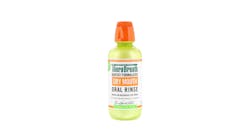Chairside Impact: TheraBreath Dry Mouth Oral Rinse
Dry mouth is a common oral condition that occurs when the salivary glands do not produce enough saliva.1 As oral-health professionals, we need to understand the impact of saliva in the oral cavity. It is also essential for us to understand the causes of dry mouth to recommend solutions and effective treatments.
Saliva is a watery liquid secreted bilaterally through paired salivary glands.2 It helps maintain and restore balance to the hard and soft tissues of the mouth with its antibacterial, antifungal, and antiviral properties.2 Calcium and phosphate in saliva aid in the prevention of enamel demineralization.
More Chairside Impact:
- The benefits of ultrasonic instrumentation
- Leveraging ultrasonics to combat biofilm, calculus, and stains
- LumaDent ErgoPrism loupes with waveLUX headlight
Decreased salivary production increases patients’ risks for caries, erosion, candidiasis, and difficulty with dentures.1 Medications, aging, tobacco and alcohol use, and cancer therapy are a few causes for decreased saliva production. Research suggests that dry mouth is common, with the highest prevalence in women and an increased frequency with age.2 Over 500 over-the-counter and prescription medications are known to reduce saliva production.1 Guggenheimer et al. stated most patients are unaware that they are experiencing dry mouth until approximately 50% of their saliva has diminished.1
What are patients saying?
Providing care to patients with dry mouth can be overwhelming. Often, patients walk into the store and purchase the first thing they see. Many patients with dry mouth say they have used over-the-counter rinses but have felt little effect, or their tissue felt thick and slimy. Other patients have tried a two-rinse process where equal parts of the rinses must be used to be effective, but most dislike these because the process is too involved. Patients need a simple, yet effective way to alleviate their dry mouth symptoms. This is why I have switched to recommending TheraBreath Dry Mouth Oral Rinse to my patients.
For patients with dry mouth
TheraBreath Dry Mouth Oral Rinse has a sweet, minty flavor and tingling sensation that soothes and moisturizes dry mouth with no slimy or thick feeling. TheraBreath is alcohol free, dye free, paraben free, and sulfate free. It contains xylitol, a sugar alcohol found naturally in plants. When introduced to the mouth, xylitol decreases the growth of Streptococcus mutans and binds to calcium ions to remineralize tooth enamel.3
The ingredient that produces the tingling sensation—Jambú flower extract (spilanthes acmella flower extract)—helps enhance the salivary experience by triggering natural salivary production.
Another reason I love TheraBreath Dry Mouth Oral Rinse is the addition of three salivary enzymes: lysozyme, amylase, and amyloglucosidase. Lysozyme is a protein found in mucosal secretions, such as saliva, and plays a vital role in immunity. Lysozyme is antibacterial, antifungal, and antiviral.4 Amylase aids in the digestion of carbohydrates in the mouth while amyloglucosidase continues to break down the carbohydrate chain that amylase started.5
When recommending TheraBreath Dry Mouth Oral Rinse to my patients, I suggest they swish with it for at least one minute. The tingling sensation will stimulate their saliva production.
Dry mouth on-the-go
For an on-the-go solution, TheraBreath has dry mouth lozenges that come in two pleasant flavors: Mandarin and Mint and Tart Berry. Both flavors contain xylitol and Jambú flower extract. The Jambú flower extract in the lozenges causes a tingling sensation that helps promote salivary production. The lozenges also contain zinc compounds, which can control plaque formation, reduce malodor, and inhibit calculus formation.6 I encourage patients to use a lozenge whenever their mouths feel dry.
I am so glad I found TheraBreath Dry Mouth Oral Rinse and lozenges to help my patients with dry mouth, and I urge you to recommend them as well.
Editor's note: This article appeared in the October 2023 print edition of RDH magazine. Dental hygienists in North America are eligible for a complimentary print subscription. Sign up here.
References
- Guggenheimer J, Moore PA. Xerostomia: etiology, recognition and treatment. J Am Dent Assoc. 2003;134(1):61-119. doi:10.14219/jada.archive.2003.0018
- Sreebny LM. Saliva in health and disease: an appraisal and update. Int Dent J. 2000;50(3):140-161. doi:10.1111/j.1875-595x.2000.tb00554.x
- Gasmi Benahmed A, Gasmi A, Arshad M, et al. Health benefits of xylitol. Appl Microbiol Biotechnol. 2020;104(17):7225-7237. doi:10.1007/s00253-020-10708-7
- Ferraboschi P, Ciceri S, Grisenti P. Applications of lysozyme, an innate immune defense factor, as an alternative antibiotic. Antibiotics (Basel). 2021;10(12):1534. doi:10.3390/antibiotics10121534
- Warren FJ, Zhang B, Waltzer G, Gidley MJ, Dhital S. The interplay of α-amylase and amyloglucosidase activities on the digestion of starch in in vitro enzymic systems. Carbohydr Polym. 2015;117:192-200. doi:10.1016/j.carbpol.2014.09.043
- Lynch RJ. Zinc in the mouth, its interactions with dental enamel and possible effects on caries; a review of the literature. Int Dent J. 2011;61 Suppl 3(Suppl 3):46-54. doi:10.1111/j.1875-595X.2011.00049.x
About the Author
Melissa Calhoun, MSDH, RDH
Melissa Calhoun, MSDH, RDH, has more than two decades of dental expertise. She currently practices clinically in San Diego, California, and has experience in different areas of dental hygiene, including pediatrics. Outside of clinical practice, she is an educator for Arm and Hammer Oral Care and the Swiss Dental Academy (SDA). She teaches National Dental Hygiene Board Examination Reviews with Sanders Board Preparatory. You can contact Melissa at [email protected] or on Instagram @missyrdh.
